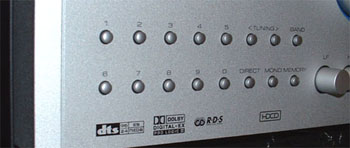ΑΝΔΡΕΑΣ Κ.
Ιδρυτής
- Μηνύματα
- 30.058
- Reaction score
- 728
Oi εκδοτες του Home Theater Mag ανακοινωσαν τα εφετινα βραβεια RAVE(Recognition of Audio and Video Excellence) με βαση τις κριτικες που ελαβαν τα προιοντα αυτα στο περιοδικο.
Και οι νικητες ειναι:
Product of the Year:
Definitive Technology Mythos Four Speaker System
Best High-End Speaker System:
Krell Resolution 2 Speaker System
Best Midrange Speaker System:
B&W LCR6000 S3 Speaker System
Best Entry-Level Speaker System:
Paradigm Cinema 70 v.2 Speaker System
Best Entry-Level Projector:
Optoma H30 DLP Projector
Best Overall Projector:
Sharp XV-Z12000 DLP Projector
Best Flat-Panel Display:
Panasonic TH-42PX25 Plasma HDTV
Best Source Component Under $500:
V, Inc. Bravo D2 DVD Player
Best Source Component Over $500:
Meridian G98DH DVD Transport
Best Amplifier Under $3,000:
Cary Audio Cinema 7 Amplifier
Best Amplifier Over $3,000:
Lexicon CX-7 Amplifier
Best Pre/Pro Under $3,000:
Adcom GTP-880 Pre/Pro
Best Pre/Pro Over $3,000:
TacT Audio TCS mkII Pre/Pro and Room-Correction System
Best Receiver Under $1,000:
Yamaha RX-V2400 A/V Receiver
Best Receiver Over $1,000:
Rotel RSX-1067 A/V Receiver
Best Rear-Projection Display:
JVC HD-61Z575 D-ILA HD Monitor
Best Home-Theater-in-a-Box System:
KEF KIT100 Instant Theatre
Best Convergence Product:
Creative Labs Sound Blaster Wireless Music System
Best Custom Product:
PSB CustomSound CHS 80 Speaker System
DVD Awards
DVD of the Year:
The STAR WARS Trilogy (Fox)
Best Video:
Once Upon a Time in Mexico (Columbia TriStar)
Best Audio:
Master and Commander: The Far Side of the World (Fox)
Best Bonus Features:
The Alien Quadrilogy (Fox)
Best Restoration:
The Good, the Bad and the Ugly Special Edition (MGM)
Best Animation DVD(s):
Walt Disney Treasures (Buena Vista)
Τωρα να υπηρχε και κανενα καλο παιδι να περνουσε και καμμια φωτο....
Και οι νικητες ειναι:
Product of the Year:
Definitive Technology Mythos Four Speaker System
Best High-End Speaker System:
Krell Resolution 2 Speaker System
Best Midrange Speaker System:
B&W LCR6000 S3 Speaker System
Best Entry-Level Speaker System:
Paradigm Cinema 70 v.2 Speaker System
Best Entry-Level Projector:
Optoma H30 DLP Projector
Best Overall Projector:
Sharp XV-Z12000 DLP Projector
Best Flat-Panel Display:
Panasonic TH-42PX25 Plasma HDTV
Best Source Component Under $500:
V, Inc. Bravo D2 DVD Player
Best Source Component Over $500:
Meridian G98DH DVD Transport
Best Amplifier Under $3,000:
Cary Audio Cinema 7 Amplifier
Best Amplifier Over $3,000:
Lexicon CX-7 Amplifier
Best Pre/Pro Under $3,000:
Adcom GTP-880 Pre/Pro
Best Pre/Pro Over $3,000:
TacT Audio TCS mkII Pre/Pro and Room-Correction System
Best Receiver Under $1,000:
Yamaha RX-V2400 A/V Receiver
Best Receiver Over $1,000:
Rotel RSX-1067 A/V Receiver
Best Rear-Projection Display:
JVC HD-61Z575 D-ILA HD Monitor
Best Home-Theater-in-a-Box System:
KEF KIT100 Instant Theatre
Best Convergence Product:
Creative Labs Sound Blaster Wireless Music System
Best Custom Product:
PSB CustomSound CHS 80 Speaker System
DVD Awards
DVD of the Year:
The STAR WARS Trilogy (Fox)
Best Video:
Once Upon a Time in Mexico (Columbia TriStar)
Best Audio:
Master and Commander: The Far Side of the World (Fox)
Best Bonus Features:
The Alien Quadrilogy (Fox)
Best Restoration:
The Good, the Bad and the Ugly Special Edition (MGM)
Best Animation DVD(s):
Walt Disney Treasures (Buena Vista)
Τωρα να υπηρχε και κανενα καλο παιδι να περνουσε και καμμια φωτο....








































